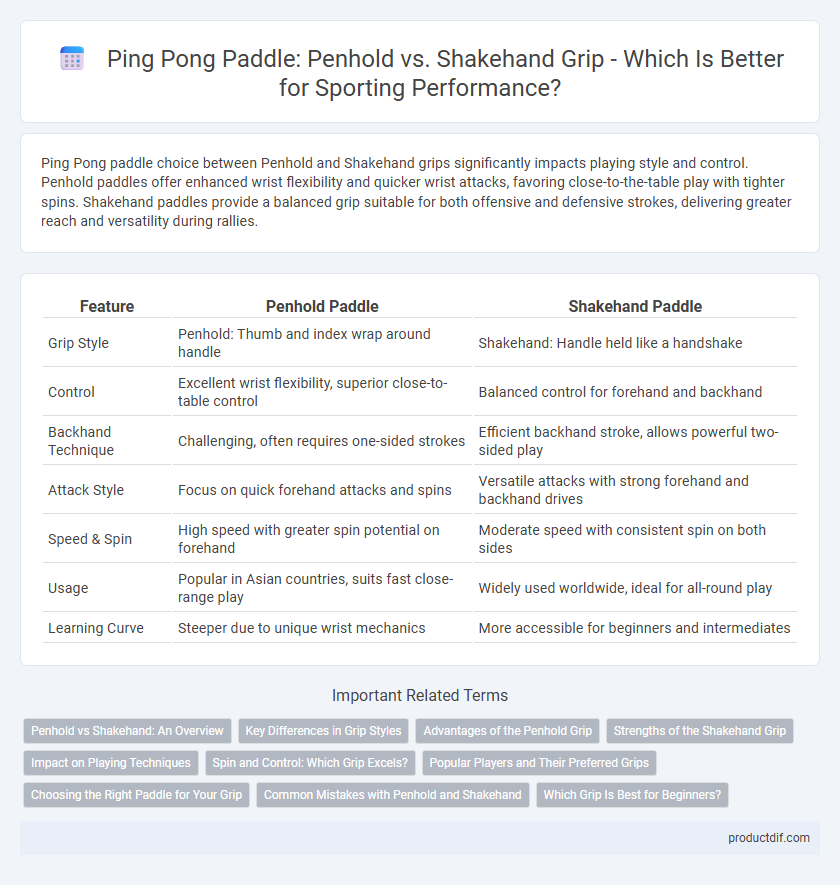Ping Pong paddle choice between Penhold and Shakehand grips significantly impacts playing style and control. Penhold paddles offer enhanced wrist flexibility and quicker wrist attacks, favoring close-to-the-table play with tighter spins. Shakehand paddles provide a balanced grip suitable for both offensive and defensive strokes, delivering greater reach and versatility during rallies.
Table of Comparison
| Feature | Penhold Paddle | Shakehand Paddle |
|---|---|---|
| Grip Style | Penhold: Thumb and index wrap around handle | Shakehand: Handle held like a handshake |
| Control | Excellent wrist flexibility, superior close-to-table control | Balanced control for forehand and backhand |
| Backhand Technique | Challenging, often requires one-sided strokes | Efficient backhand stroke, allows powerful two-sided play |
| Attack Style | Focus on quick forehand attacks and spins | Versatile attacks with strong forehand and backhand drives |
| Speed & Spin | High speed with greater spin potential on forehand | Moderate speed with consistent spin on both sides |
| Usage | Popular in Asian countries, suits fast close-range play | Widely used worldwide, ideal for all-round play |
| Learning Curve | Steeper due to unique wrist mechanics | More accessible for beginners and intermediates |
Penhold vs Shakehand: An Overview
Penhold and Shakehand are two primary grip styles in ping pong, each offering distinct advantages for different playing techniques. Penhold grip provides greater wrist flexibility and is favored for quick, close-to-the-table play, while Shakehand grip offers a balanced reach and powerful backhand strokes. Choosing between Penhold and Shakehand depends on player preference, playing style, and strategic goals in table tennis performance.
Key Differences in Grip Styles
The key differences between the Penhold and Shakehand Ping Pong paddle grips lie in hand positioning and stroke versatility. The Penhold grip, originating from Asia, allows for greater wrist flexibility and quicker close-to-the-table play but limits backhand reach. The Shakehand grip, favored globally, provides balanced forehand and backhand strokes, offering better control and power for a wide range of playing styles.
Advantages of the Penhold Grip
The penhold grip offers superior wrist flexibility, allowing for faster, more versatile spins and quick offensive strokes, particularly effective in close-to-the-table play. This grip enhances control over the ball's placement, facilitating precise flicks and tricky serves that can disrupt opponents' rhythm. Many professional players favor the penhold style for its ergonomic comfort and ability to generate sharp, aggressive angles during rallies.
Strengths of the Shakehand Grip
The shakehand grip offers superior reach and versatility, allowing players to execute both offensive and defensive strokes with ease. It provides powerful backhand and forehand drives, enhancing control and speed during fast rallies. This grip style supports a balanced wrist movement, contributing to consistent spin and shot accuracy across various playing styles.
Impact on Playing Techniques
Penhold paddles enable increased wrist flexibility, allowing players to execute swift, deceptive spins and closer-to-the-table play, enhancing quick attack techniques. Shakehand paddles provide a larger hitting surface and facilitate more powerful forehand and backhand strokes, supporting versatile mid-to-long-range rallies. These differences significantly influence stroke mechanics, footwork, and overall strategy in table tennis gameplay.
Spin and Control: Which Grip Excels?
Penhold grip in ping pong provides superior wrist flexibility, allowing players to generate intense spin and execute quick, precise shots, enhancing offensive control. Shakehand grip offers balanced control and power with easier backhand strokes, favoring consistent spin over rapid variation. Competitive players often choose penhold for aggressive spin techniques, while shakehand excels in consistent control and versatile shot placement.
Popular Players and Their Preferred Grips
Top ping pong players exhibit clear preferences between penhold and shakehand grips, influencing their playing styles and success. Ma Long, a dominant force in international table tennis, favors the shakehand grip for its versatility and power, while Fan Zhendong also employs the shakehand grip, maximizing speed and spin. On the other hand, players like Wang Hao have popularized the penhold grip, showcasing exceptional wrist flexibility and close-to-the-table control, highlighting the grip's unique advantages in the professional arena.
Choosing the Right Paddle for Your Grip
Selecting the right ping pong paddle depends heavily on whether you use the penhold or shakehand grip, as each style demands different paddle characteristics for optimal control and spin. Penhold paddles typically feature a shorter handle and thicker blade to accommodate wrist flexibility and quick flicks, enhancing close-to-the-table play. In contrast, shakehand paddles have longer handles and larger blades, providing balanced power and versatility suited to both offensive and defensive strokes.
Common Mistakes with Penhold and Shakehand
Common mistakes with penhold grip include excessive wrist movement causing instability and limited reach, reducing defensive effectiveness. Shakehand players often err by gripping the paddle too tightly, hindering fluid strokes and increasing fatigue during extended play. Proper technique adjustment and grip relaxation are essential to maximizing control and power in both styles.
Which Grip Is Best for Beginners?
The shakehand grip is generally considered best for beginners due to its versatility and ease of learning, allowing players to comfortably execute both forehand and backhand strokes. Penhold grip, while offering superior wrist flexibility and close-to-the-table control, may require more advanced technique and practice. Players new to table tennis typically benefit from the balanced approach and straightforward mechanics of the shakehand grip.
Ping Pong Paddle Penhold vs Shakehand Infographic

 productdif.com
productdif.com